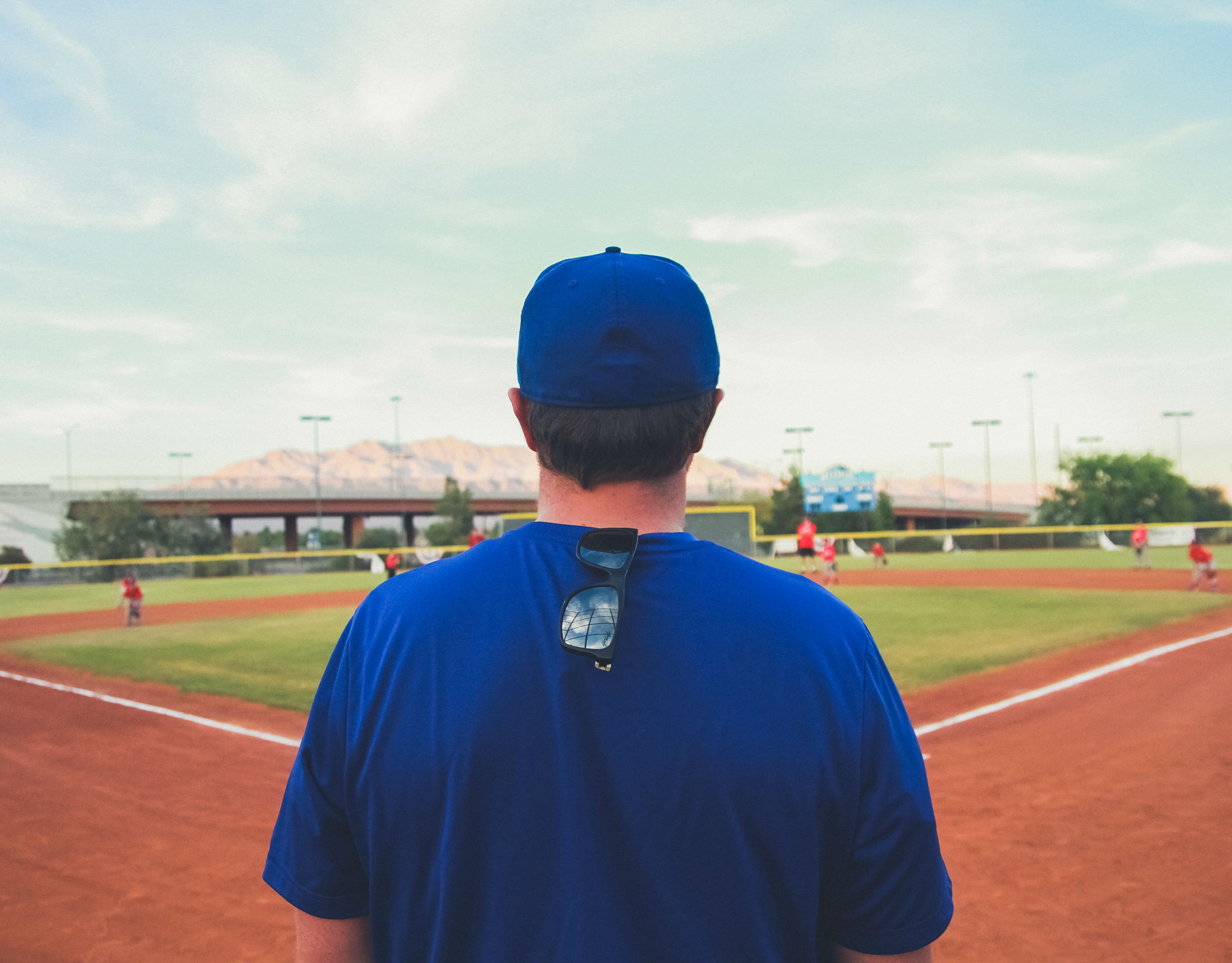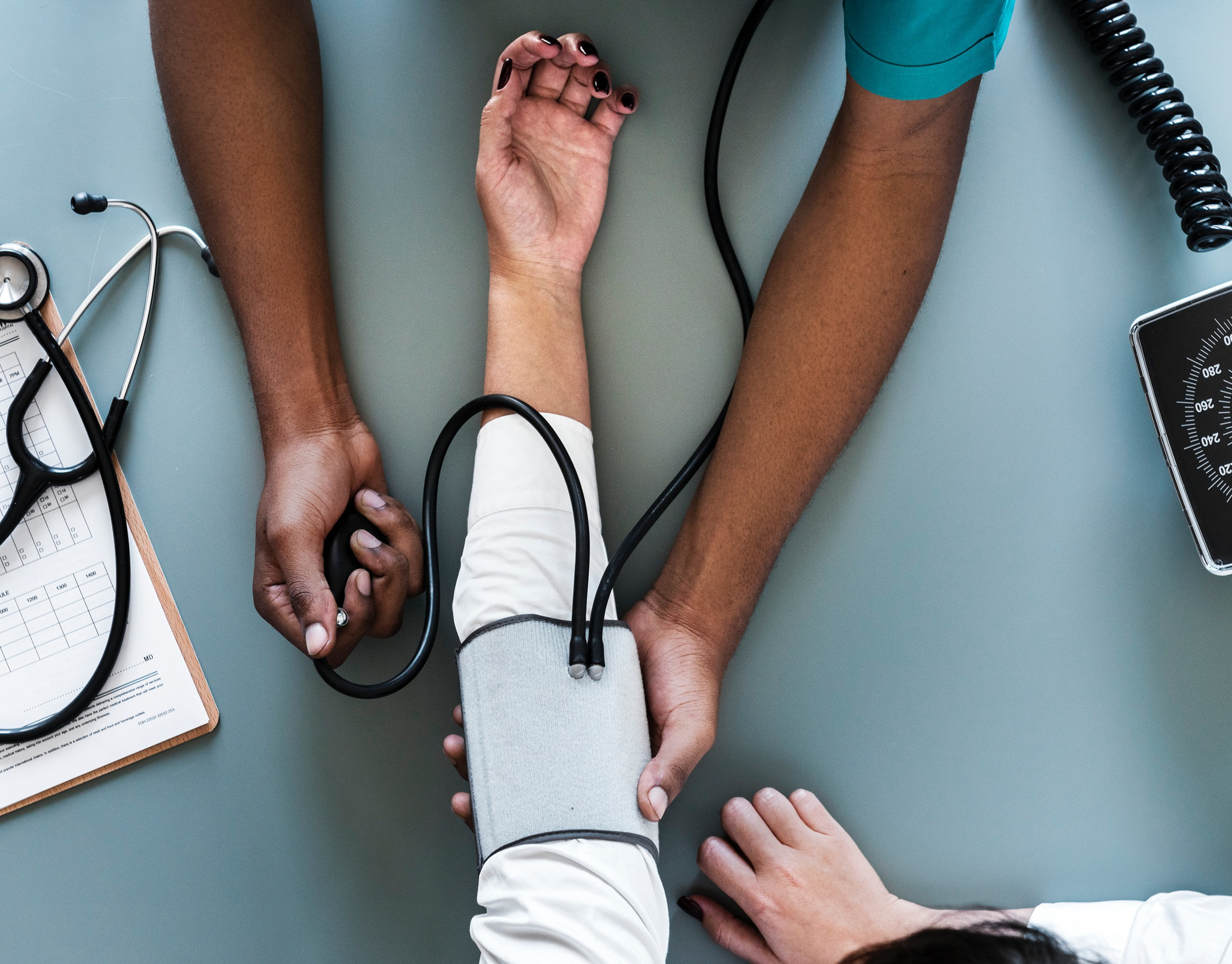Project Overview
This is an independent specialization project that I conducted over the course of a semester as part of our UX Design Learning Studio 5. This project primarily focuses on deep qualitative user research and analysis, but I also did some ideation and design work.
I chose the context of type 1 diabetes for this project because there are several people in my life with type 1 diabetes, including my two younger brothers, and it's a subject that is very important to me, as well as something I wanted to learn more about.
Learning Objectives
With this being a personal, specialization project, I created four learning objectives that I wanted to get out of this project to help me grow as a user researcher and practitioner. These learning objectives helped determine what types of methods and strategies I used for the project.
1. Learn and apply a new research method that is more engaging for the participant that I have never used before.
2. Engage deeply with and listen to type 1 diabetics and their caretakers to identify struggles that may not be addressed with current technology and solutions.
3. Explain type 1 diabetes and how people live with it in a comprehensive way for any audience and set of stakeholders to understand and empathize.
4. Design an interaction solution incorporating multiple devices that addresses the problem found in research.
Methods
Based on my learning objectives, I created a list of methods I would use
Research Methods
• In-depth one-on-one interviews with type 1 diabetics and caretakers using the directed storytelling approach. Conducting interviews will help me identify a narrowed problem space and help me in my development of personas to communicate to my audience who the users are.
• Diary study with type 1 diabetics. A diary study will help me get a better understanding of the day-to-day lives of type 1 diabetics, problems that occur, and their emotions in relation to their blood sugar. This is also a research method I have never used before, accomplishing my first learning objective.
• Secondary research on recent HCI studies that have been conducted in the similar context of diabetes. Reading about other studies already done in this subject will help me better understand what has already been looked at and what gaps there are in this context.
Analysis Methods
• In-depth analysis to identify themes and insights across research results and synthesize to formulate a narrowed problem statement.
• Create personas based on research findings. Creating personas will help me communicate what specific users I’m designing for and help me address their goals and pain points in my design.
• Create some type of journey map to better illustrate the personas' experiences over time.
Design and Evaluation Methods
• Constant ideation and sketching throughout the project to generate several potential solutions.
• Wireframe best final solution to illustrate the functionality and flow that would help solve the problem found in research.
• Receive continuous feedback on ideas and wireframe from a type 1 diabetic or caretaker to find improvements that can be made towards the solution.
• Conduct a persona walkthrough evaluation of the final solution to identify points of tension that my personas might encounter when using the solution and opportunities to improve on the experience of the solution.
Interviews
As part of this project, I wanted to engage deeply with and listen to type 1 diabetics and their caretakers to understand their stories and identify struggles they have in relation to their diabetes. To do this, I conducted in-depth, semi-structured with both type 1 diabetics and a diabetic caretaker, utilizing the directed storytelling method within my interview protocol so interviewees would explain their personal stories and journeys with their diabetes.
Process
l conducted interviews with five type 1 diabetics and one caretaker. Each interview lasted between 45 minutes to an hour and was audio recorded.
In the interviews with diabetics, I covered three main topics: their diagnosis experience, their adjustment to their new lifestyle, and how they currently manage their diabetes. I also asked a few questions on their decision-making process in relation to their diabetes.
In the interview with the caretaker, the topics I covered were: how they learned how to take care of their diabetic, how their caretaking has changed over time, and their experience as a caretaker as a whole.
To analyze the interviews, I used the spreadsheet and database tool Airtable. I created a sheet for each interviewee and recorded important notes and quotes with their timestamp. I then coded themes for the notes and quotes, and created a separate sheet to collect and organize all of the themes found. I also created a separate sheet identifying pain points across interviews.
Airtable interview data analysis
Lastly, I summarized each interview into a short page because I wanted to capture and appreciate how unique and different each interviewee's story was.
Themes and Findings
Overall, I synthesized my data and identified 10 themes and 8 unique findings from my interviews. In a report, I explain each theme and finding and provide supporting quotes from interviewees.
Diary Study
As part of this specialization project, I wanted to apply a new research method that I have never used before that is more engaging for the participant. I decided to use the diary study method to do this because I wanted to gain a better understanding of the day-to-day lives of type 1 diabetics, problems that occur, and how they handle them. I also was interested in how they find the experience of consistently logging things they do for their diabetes and reflecting on how they were feeling mentally/emotionally in relation to their blood sugar.
Process
Four of the diabetics that I interviewed participated in the diary study. Each participant completed multiple diary logs each day throughout the span of three days.
I conducted the diary study through the app Evernote. I did this by creating folders for each participant that included a note with directions and several entries for them to fill out for each day using the journal template I created. I asked each participant to download the app Evernote on their phone, and then I shared the corresponding folder to each of them. I also set a reminder each day in the app in case the participant forgot to log for that day.

Participant Evernote folders

Filled out entries by participant
I asked the participants to complete a journal entry every time they did some type of management for their diabetes, such as checking their blood sugar, giving themselves insulin, or correcting a high or low blood sugar. The journal template that I provided prompted them explain what they just did for their diabetes, how they were feeling mentally and/or emotionally, if they encountered any problems, and if there could be anything that could have helped them make that management easier.
While I supplied them a template, I encouraged them in my directions to fill out whatever they found was necessary, even if it wasn't on the template. One of my participants provided photos of what they were doing and screenshots of their diabetes app in their journal entries. Another participant decided to voice record her journal entries, making them much more personal.
At the end of the study, I also interviewed each participant about their experience with the journaling.
Takeaways
I analyzed both the raw results of each participant's journal entries and their post-interview and developed a few takeaways:
• Some type 1 diabetics are much more interested in learning and understanding how their own bodies work in relation to their diabetes. While other diabetics are much more complacent and don't find their diabetes important enough to reflect on and think about much.
• Type 1 diabetics often don't have feelings towards their diabetes unless their blood sugar is extremely low or extremely high.
• More experienced type 1 diabetics usually know exactly what they need to do in any situation. There is very little unknowing or lack of confidence.
• Type 1 diabetics do the same things so often that they don't even realize how much they have to do for their diabetes, and it becomes just part of their routine.
• Type 1 diabetics often have to guess how many carbs are in the meal they are eating, which can take a lot more time and can be frustrating.
With all of these themes and findings from my interviews and diary study, I then looked to narrow my scope and identify potential problem spaces to focus my project on.
Narrowing Scope
From the primary research that I conducted and the themes and findings that I generated, there were several interesting problem spaces within type 1 diabetes that I identified. I narrowed down to 6 problem spaces that I found particularly interesting:
• Type 1 diabetics often have to guess how many carbs are in the meal they are eating, which can take a lot more time and be frustrating. While older diabetics have a lot of experience in guessing carbs, newer diabetics are often unsure and have to spend a lot of time looking up and calculating the amount of carbs.
• Type 1 diabetics can become complacent about out-of-range blood sugar numbers and often forget what can happen in the future if they don’t take good care of themselves now.
• Type 1 diabetics find that the physicality of the insulin pump always at their side can weigh them down, get in the way, and just become an annoyance at times.
• Type 1 diabetics are usually not able to proactively act on things before they go bad and instead have to react after something has already gone wrong.
• Caretakers of young type 1 diabetics have difficulty with tracking and managing their diabetic’s blood sugar when they are not around, especially during the night.
• Young adult female type 1 diabetics have unique problems and perspectives and no current solutions that try to solve these problems and perspectives.
After exploring these different problem spaces and getting feedback from my professors and peers, I decided to narrow down to the problem space of carb counting and guessing because it was a space I found the most intriguing and has had little exploration in research and literature.
Problem Statement
From this problem space and based off my primary research findings, I created this problem statement to frame the rest of my project around:
"Newly-diagnosed type 1 diabetics need a way to accurately determine the amount of carbohydrates that are in their meals they are unsure about because their lack of experience in this area often causes them to spend excessive time looking up and calculating carbs, and they can often give themselves inaccurate amounts of insulin which causes high or low blood sugar."
In this case, I am referring to lack of experience as newer diabetics not having the experience and knowledge of guessing carbohydrates that older diabetics have developed over the years of having to guess constantly. I found in my research that diabetics get better at guessing carbohydrates just from the experience they have had from doing it for so many years.
Personas
One of my learning objectives for this project was to explain type 1 diabetes and how diabetics live with it in a comprehensive way for any audience to understand and be able to empathize. To help me accomplish this learning objective, I decided to create personas. Not only are these personas a way to help me tell a story, but I also actively used them throughout my ideation and design phases to make sure I am constantly empathizing with the user and keeping their needs and pain points in mind.
These personas are based largely off of my research participants and the themes and findings I developed from my discovery research phase. The first one, Devin Thompson, is my primary persona because he is a newly-diagnosed type 1 diabetic, which is the main user I am focusing on for this project. Kristen Webb is my secondary persona who is more of an expert in managing her diabetes, but I still want to try to address some of her needs and pain points as well.

Primary persona overview
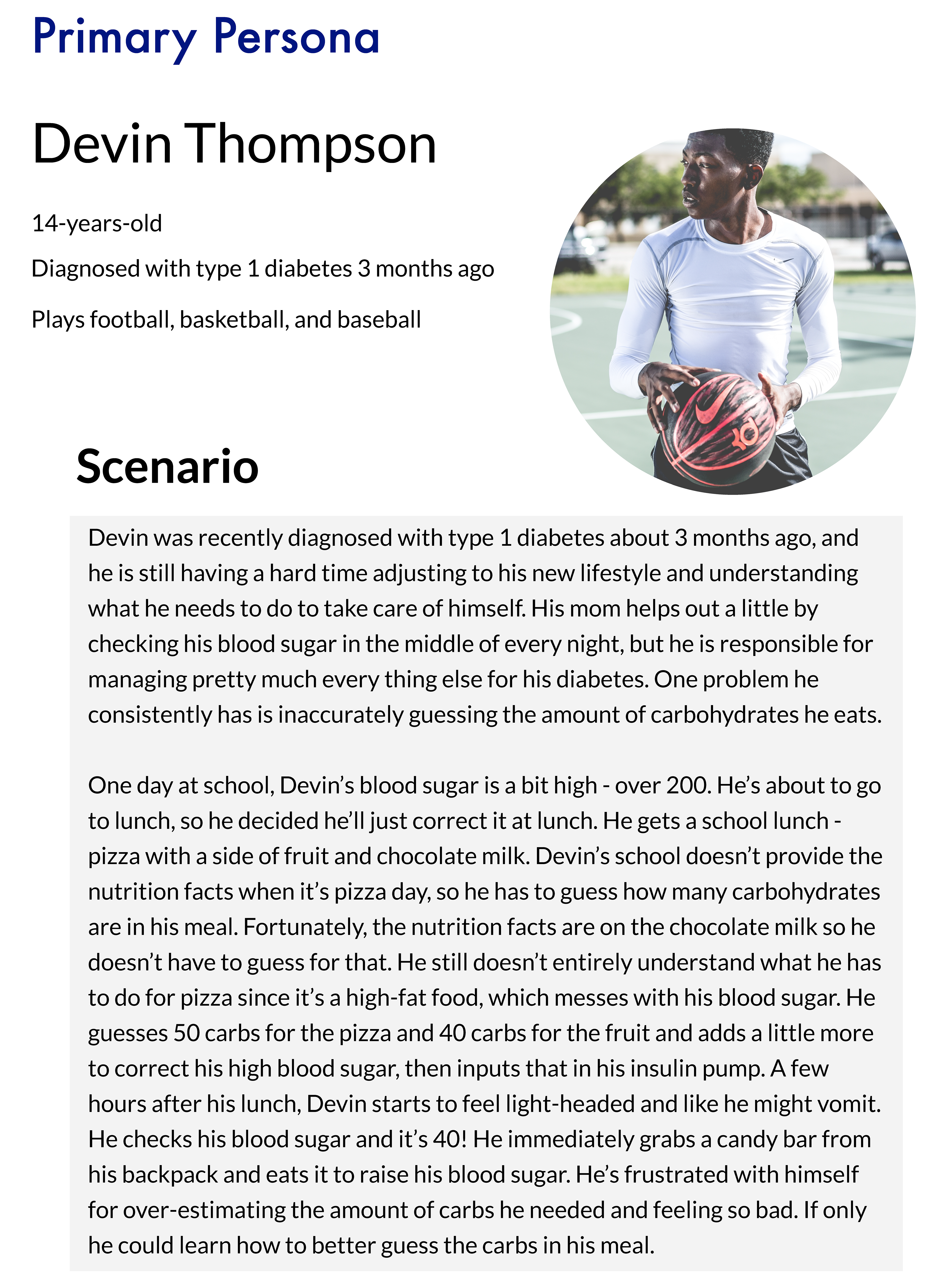
Primary persona scenario

Secondary persona overview
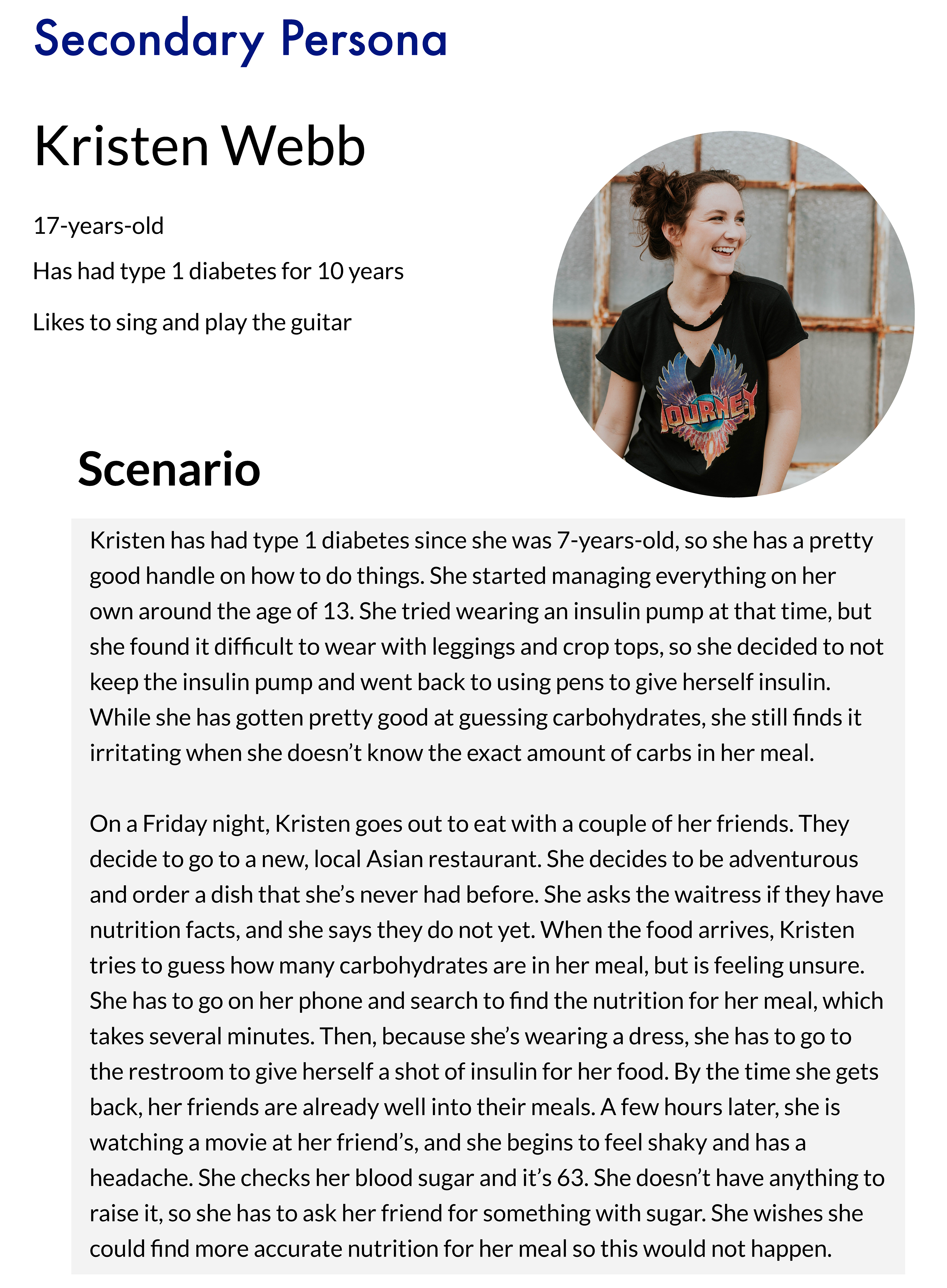
Secondary persona scenario
Temporal User Journey of Expertise
I created a temporal user journey mapping out the level of expertise a type 1 diabetic is at following the years of their diagnosis, and I plotted my personas on the map. I also wrote the typical understanding and behaviors a diabetic has related to their expertise level 1 year after their diagnosis, 5 years, and 10 years. This helped me when ideating on how I could help newer diabetics grow that level of expertise quicker.
Ideation
Based off my research findings, problem statement, and personas, I ideated and sketched out several potential concepts for a solution to my identified problem. There were three main insights from my research and analysis that I focused on when ideating:
• Type 1 diabetics often have to guess how many carbs are in the meal they are eating that they are unfamiliar with, which can take a lot more time and can be frustrating. Also, high-fat foods, such as pizza, often can cause a rollercoaster of blood sugar numbers because it is hard to determine what it does to the body.
• Through everyday experience and learning how to deal with different situations, over time type 1 diabetics grow their level of expertise. This involves learning to better guess the amount of carbs in their meals, knowing how certain foods and other factors effect their blood sugar, and knowing what to do in various situations. This level of expertise can take 5+ years to get to.
• After first being diagnosed, new diabetics are given so much information that it can often times be overwhelming and difficult to comprehend all of it. It can take a long time to truly understand what they are doing, why they are doing these things, and how their blood sugar is affected by different factors.
Sketches
Using these three insights, I sketched out several ideas that could help solve the problem I found, and listed out the pros and cons of each of them. Below are some of my initial sketches.

App for the user to take a photo of there food and determine how much insulin to dose for
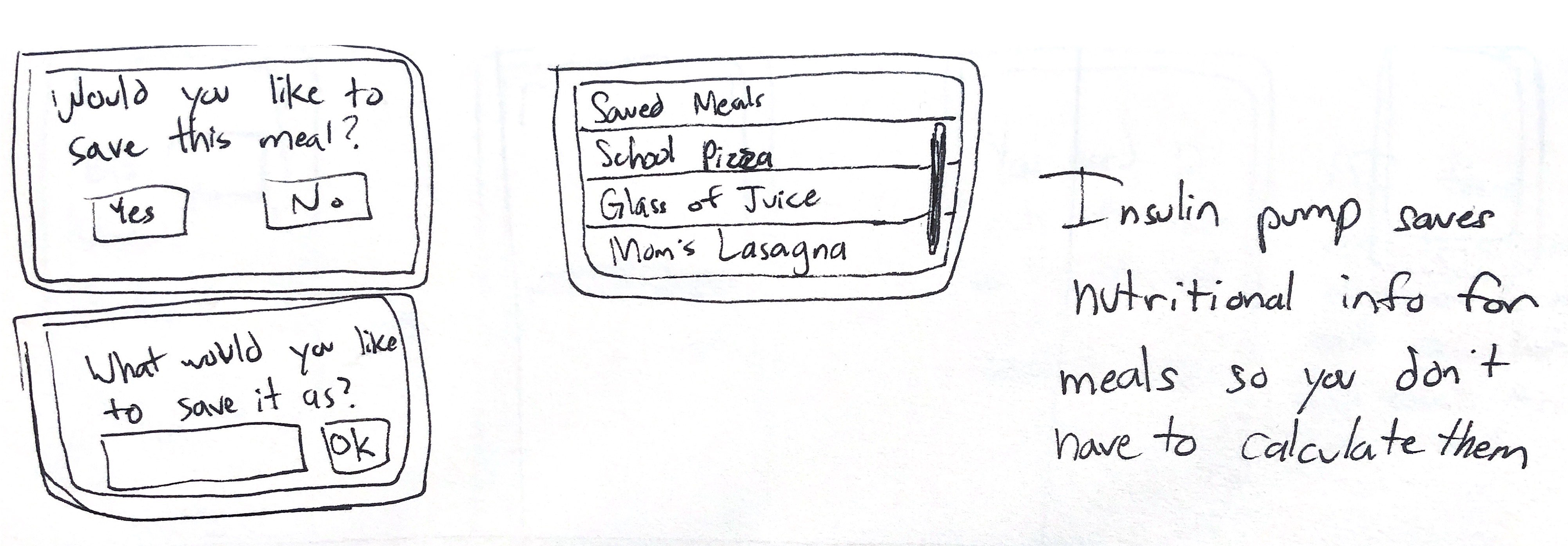
Save nutritional information for meals in the insulin pump

Crowdsourcing app for diabetics to share nutritional information for their meals

Insulin pump reacts instantly based off the food the diabetic consumes
Secondary Research
As I was in the ideation phase, I came across three diabetes-related HCI research articles that helped guide and focus my ideation a little more.
Takeaways
One takeaway that I got from the article Investigating Health Management Practices of Individuals with Diabetes was focusing on the ideas of reflection and learning, rather than simply providing the number of carbs to the user. By forcing the user to reflect on their actions in correlation with their blood sugar, they are more likely to internalize the new learned understanding and modify their behavior.
The article Designing for Diabetes Decision Support Systems with Fluid Contextual Reasoning mentioned and explained the Sensemaking theoretical framework, which helped me realized that one of my goals is to help new type 1 diabetics make sense of their out-of-range blood sugar numbers and encourage experimentation of new behaviors.
Lastly, the article Seeking Health Information in the Diabetes Online Community (DOC): The Role of Health Literacy, Social Support and Community Engagement on Treatment Adherence provided me the takeaway that the Online Diabetes Community offers unique information that helps inform decision making that type 1 diabetics can't find anywhere else. The online community also provides type 1 diabetics social and emotional support from others who are going through a similar experience.
I used these three takeaways of reflection, sensemaking, and online communities to iterate on my initial ideas, and they ultimately helped me create and design my final solution.
Final Solution

Final solution app homepage - list of meals
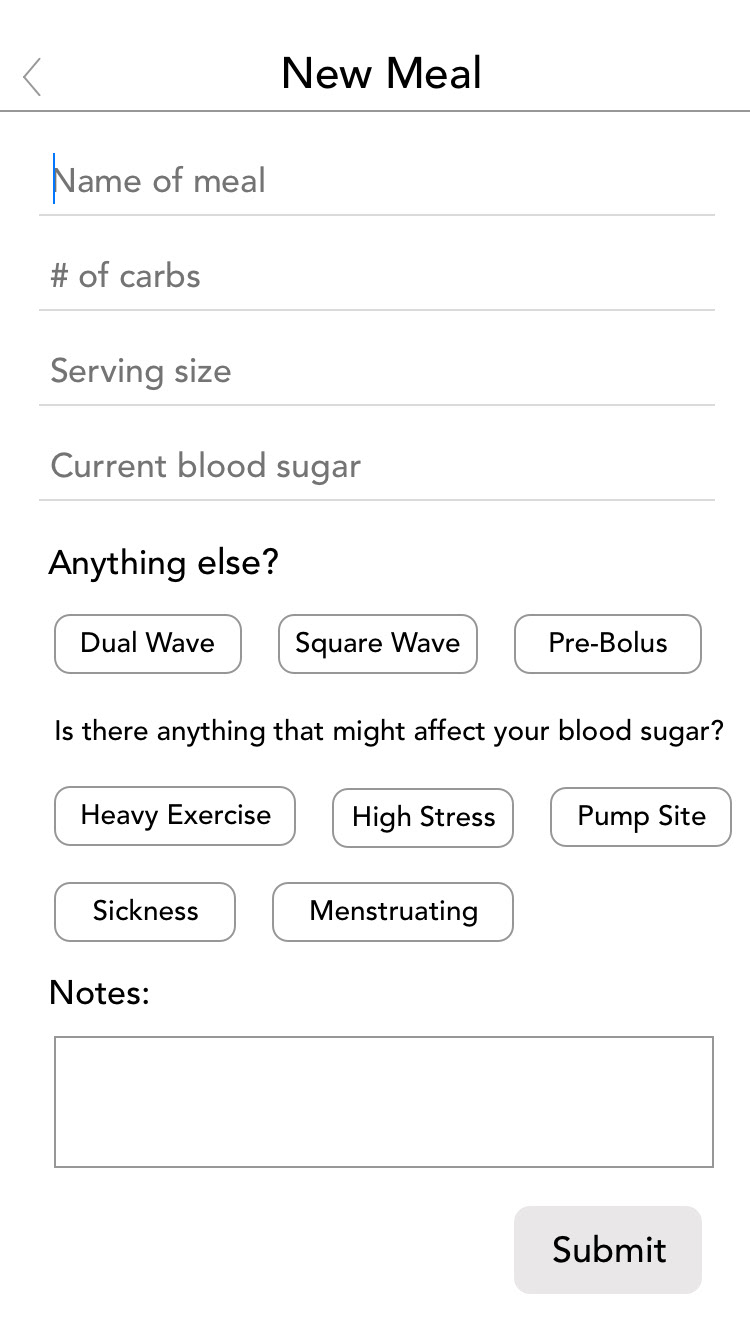
Final solution adding a new meal
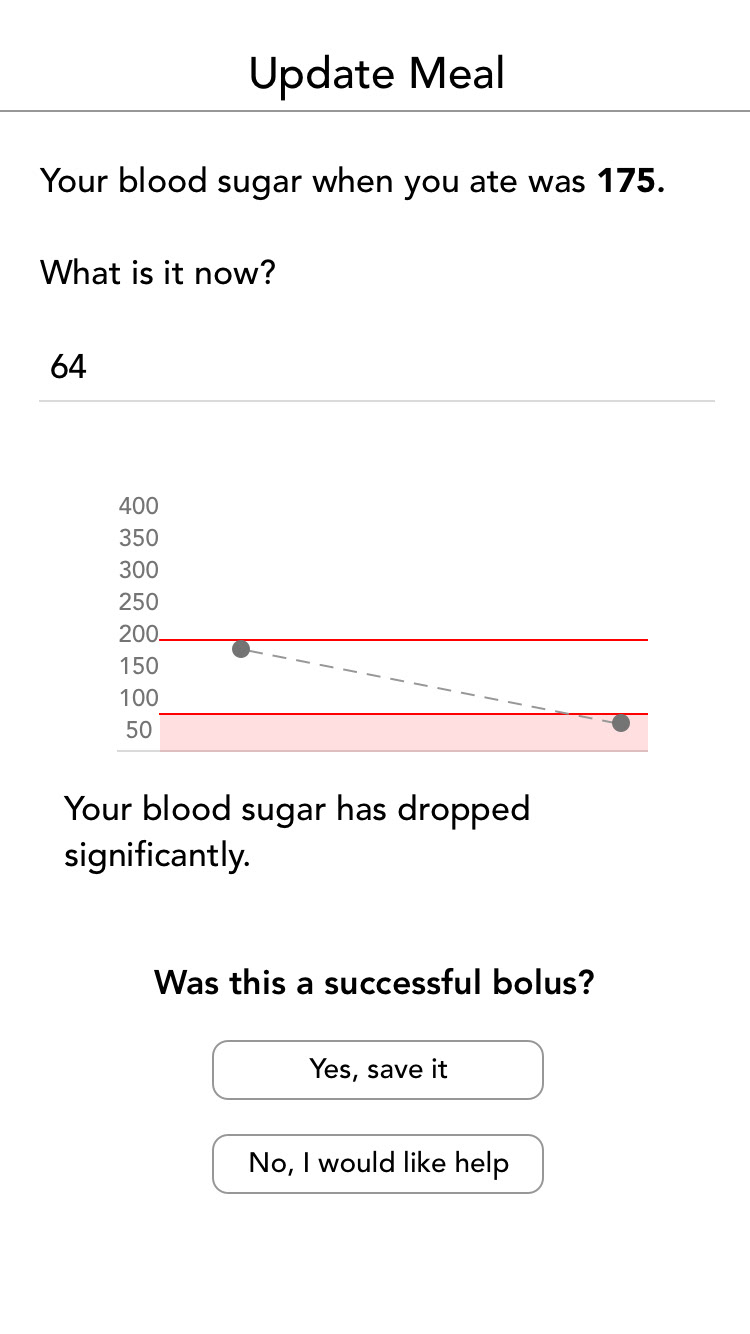
Final solution change in blood sugar

Final solution community help
My final solution is an app with two main parts. The first part is a space for the type 1 diabetic or their caretaker to add and save meals that they eat frequently with the amount of carbohydrates they dosed for and anything else related to their insulin dosage and blood sugar. When they add a new meal, they are prompted to reflect on whether they think that dosage was successful. If the dosage was not successful, the app provides a recommendation on what they could do differently next time. When they have the same meal at a later time, they can see all of the information on their meal list, and if they have an insulin pump, they can send that information to their insulin pump.
The second part to the app is a crowdsourcing feature. When a user goes to a local restaurant, they can add the meal they ate and their dosage to the app for other type 1 diabetics to see and help them better guess on how to dose for their meal.
The overall purpose of this solution is for newer diabetics to build their competency and expertise in carb guessing quicker and understand how different factors affect their blood sugar. It also is a way for diabetics to help one another and build a sense of community.
I used Sketch to wireframe the solution. I chose wireframes as my final fidelity of the project because I was more concerned about the form and function of the app rather than the visuals.
Solution Evaluation
I used two methods to evaluate my solution and wireframe: feedback from a type 1 diabetic caretaker, and a persona walkthrough evaluation.
Feedback
To evaluate my solution, I first had an informal feedback session with a caretaker of a type 1 diabetic where I gave her an overview of the app and showed her each for any feedback.
Overall, she liked the concept of the app, and she even would have used it at the beginning when her son was first diagnosed with diabetes. She used to have a method where she would right down meals and their information on the whiteboard in their kitchen, so she really liked the ability to save meals and use them for later.
She also provided suggestions such as other selections for pump settings, other factors that affect blood sugar on the new meal page, and changing the wording of some of the screens to be more accurate. I made changes to the wireframe based off of her feedback.
Persona Walkthrough Evaluation
The second way to evaluate my solution was by conducting a walkthrough of the wireframe prototype in the mindset of my personas. I chose this method of evaluation because I do not have quick access to my primary user group (newly-diagnosed diabetics). By thinking through how my personas would use this app and problems they would come across, I can better understand how a user from my user group would find my solution.
Process
I walked through the 3 main use cases of the app with the persona whose scenario and needs best matches each use case. At each step of each use case, I identified potential points of tension that the persona might experience when using the app, as well as opportunities of where there could be improvements and better functionality. I mapped out each use case with the tensions and opportunities found at each step. I made changes to the wireframe prototype based off some of the opportunities that I found from this evaluation. The opportunities that I did not make changes to are part of my next steps for the project.
3 Use Cases with Personas
Adding a New Meal - Devin Thompson
Viewing Saved Meal and Sending to Pump - Devin Thompson
Community Help Section - Kristen Webb
Results
Conclusion and Final Thoughts
To summarize, I started from the broad context of type 1 diabetes. After conducting in-depth primary user research and heavy analysis, I narrowed down my problem space to newly-diagnosed type 1 diabetics needing a way to better guess the carbohydrates in their meals and increasing their level of expertise quicker than average.
The final solution I came up with and wireframed is an application for type 1 diabetics or their caretakers to add and save meals with the information needed for a dosage. Users are prompted to reflect on whether the dosage was successful after adding a new meal, if it was not, they are provided with a recommendation on what they can do better next time. There is also a crowdsourcing section for users to add dosage information on meals from local restaurants. The purpose of the app is to help type 1 diabetics or their caretakers build their competency and expertise in carb guessing quicker and understand how different factors affect their blood sugar.
Next Steps
There are still several things I would want to do with this project if given more time. I would want to improve on the UI and display of information to make it seem less medical and more user-friendly. I would also want to conduct longer-term testing with actual newer type 1 diabetics to see if this solution would add value to their diabetes management and help raise their level of expertise.
Overall, this was an incredible experience to be able to work in a context I care so deeply about and utilize my strengths and passions into a project. I was able to learn so much about the lives and experiences of some of the people with type 1 diabetes, which I found to be the most eye-opening and impactful part of the project for me. I am very thankful to my research participants who were incredibly open with me about some pretty personal topics. I have never been so satisfied and fulfilled from working on a project in my life, and I feel grateful for the opportunity.

